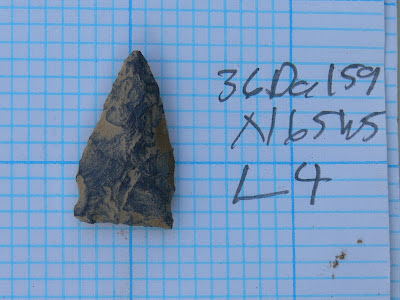 |
| Black plastic covering our excavation block and protecting the site from overnight rain |
Excavations continued this week at Fort Hunter and despite intermittent showers the crew was able to put in a full week at the site. Our process of covering the entire excavation block ( about 20’ x 60’) with 8-mil black plastic would make an engineer scratch his head- but there is a method to the madness. We manage to cover the units every night and uncover them the next morning, pretty unscathed. When it rains, the challenge is to remove the water off of the surface of the plastic without letting it run onto the units below. We have added a new tool to our supply kit for the dig- Pig Pillows -super absorbent pillows that we use to soak up the water that does manage to get through the plastic. An unconventional tool, but one that has helped us keep the project moving.
 |
| Pig Pillows absorbing water which seeped into our unit |
This week, the final sections of Feature 47 were mapped and excavated. This is a large, approximately 8 feet in diameter, fire-cracked rock (fcr) feature to the north of the well (see previous blogs). This sounds so simple, but the process of mapping and recording each of the pieces of fcr requires both time and patience. Each of these pieces is bagged separately, so each bag requires all of the provenience information to insure proper cataloging.
 |
| Mapped fcr back at the lab awaiting cataloging |
Our volunteers that help process the collections in the lab are always amazed at the process of recovering artifacts in the field and recording those artifacts to insure that provenience information is retained for each piece recovered. Getting back to the site, removing this feature allowed for the removal of soils in these two units which are dating now to the Late Archaic period. Fewer artifacts are present at this level, but we continue to recover chipping debris from lithic tool production or resharpening of tools.
 |
| Our fcr feature (#47) removed with the floor cleaned and level on the north end of the excavation block. |
On the south side of the well, our efforts have focused on removing soils from the levels surrounding the well. Our visit last week with Dr. Frank Vento confirmed our theories on the soil changes we are experiencing in these units. These sandy soils contain evidence of flooding episodes occurring along the Susquehanna River over thousands of years. Random pockets of water washed cobbles were deposited there as the channels of the river shifted and changed over time. Removal of one of these large cobbles yielded a charcoal deposit which we anticipate testing using AMS (accelerator mass spectrometry) dating. We expect a date between 10,000 and 12,000 years old.
 |
| charcoal deposit located to the left of photo board in photo |
 |
| South end of the well all units at same level |
All of our efforts in the prehistoric levels are leading up to the dismantling of the well. The well shaft has been cleared of about another three feet of debris, which continues to contain 19th century ceramics, glass and oyster shell. Our volunteers Seth and Jerry have done a great job with this feature. Our goal is to remove several more feet of debris and then auger again to see if the coal ash, oyster shells and 19th century artifacts continue in the lower levels.
 |
| Jerry has removed another foot of fill from the well shaft- how low will he go? |
The number of visitors to the site has been fantastic and we have had a lot of assistance from our many faithful volunteers. The staff of Fort Hunter Mansion and Park are great to work with and the ladies have been bringing lots of visitors to the mansion out to our excavations. We are just over the half-way mark for the excavation so if you haven’t stopped by to see us, now is the time.
 |
| Home School Day attendees in the Fort Hunter exhibit on the 2nd Floor of The State Museum |
Our fall programming at The State Museum included the annual Home School day on Wednesday, September 26th . This program is organized by our Education Department and their staff pulled together a great series of activities for the students and parents. Presentations in our gallery included a Lenape Indian story presented by Bobbie Glass and an introduction to the excavations at Fort Hunter in our alcove exhibit. Preparations are well under way for Archaeology Month activities including Indian Day at Fort Hunter on October 7th and Society for Pennsylvania Archaeology at Cabela’s on October 21st. These events are followed by the Workshops in Archaeology, see link on right column, offered at The State Museum on November 3rd.
Next week is October and the beginning of Archaeology Month in Pennsylvania. This is an opportunity to visit archaeological sites and exhibits across the Commonwealth and learn about your communities’ archaeological heritage. The local chapters of the Society for Pennsylvania Archaeology are conducting special programs during the month and they would love to see you at their events. Remember to record your archaeological sites with the Bureau for Historic Preservation and remember it is up to you to help us to Preserve our Past for the Future.
For more information, visit PAarchaeology.state.pa.us or the Hall of Anthropology and Archaeology at The State Museum of Pennsylvania .




















